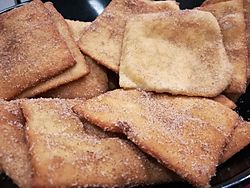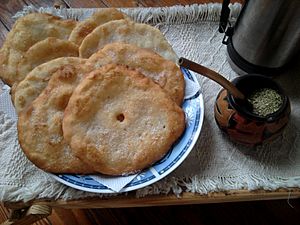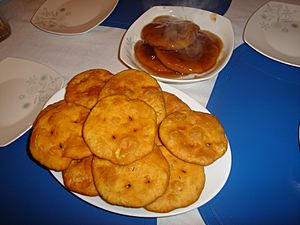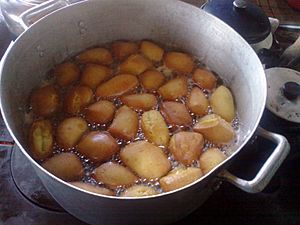Sopaipilla facts for kids

New Mexican dessert sopaipillas
|
|
| Main ingredients | Leavening agent, wheat dough (or wheat flour and masa harina), shortening or butter |
|---|---|
A sopaipilla is a yummy fried pastry. It's a type of quick bread. You can find it in many places in the Americas where people speak Spanish. The name 'sopaipilla' comes from an old Spanish word, 'sopaipa'. This word meant "bread soaked in oil." It came from an even older word that meant "bread soaked in liquid."
Sopaipillas are usually made from wheat dough. Sometimes, they use a mix of wheat flour and masa harina. A little shortening, like butter, is added to the dough. After the dough rises, it's rolled flat. Then, it's cut into circles, squares, or triangles. Small ones (about 8-10 cm) are for dessert. Bigger ones (15-20 cm) can be stuffed for a main meal. These pieces are deep-fried in hot oil. When they fry, they puff up. This often creates a hollow space inside.
Contents
The History of Sopaipillas
Fried cakes have been made for a very long time. People started making them around 5000 to 3000 BCE. This was when they first had pots to hold oil. Frying cakes was an early way to cook, like baking. It only needed fire and a simple pot. Almost every culture has its own fried cake. Sopaipillas are a special kind found in Latin American cuisine, Tex-Mex cuisine, and the cuisine of the Southwestern United States.
Different Kinds of Sopaipillas
Sopaipillas can be made with yeast or as a quick bread. Some recipes add pumpkin to the dough. This makes them extra tasty!
Sopaipillas in Argentina
In Argentina, this pastry has other names. People call it torta frita, kreppel, or chipá cuerito.
Sopaipillas in Chile
In Chile, people have eaten sopaipillas since at least 1726. Traditional Chilean sopaipillas often have cooked pumpkin in the dough. This is common in central Chile. But in the south, they usually don't add pumpkin.
Chilean sopaipillas can be served in different ways. As a snack, they might come with pebre. This is a sauce made with chili pepper, onion, garlic, and coriander. Or, they can be boiled in chancaca sauce. This is a sweet, hot syrup made with panela, orange peel, and cinnamon. When served this way, they are called sopaipillas pasadas. People also eat them with mustard, ketchup, hot butter, avocado, or cheese.
Chileans often make sopaipillas at home. They are a popular treat on rainy days. You can also find them as street food. Chilean sopaipillas are round and flat. They usually have holes poked in the middle with a fork.
In the Chiloé Archipelago, sopaipillas are shaped like diamonds. They are usually sweet. People eat them with jam or honey. They are also a key part of reitimientos. This is a traditional feast related to processing fats after a pig slaughter.
Sopaipillas in Peru
In Peru, this fried pastry is called cachanga. It can be sweet or sour. People often make it for breakfast. This traditional Peruvian food is made differently in various regions. One recipe uses cinnamon. The main difference is that Peruvian cachangas are bigger, thinner, and more firm than other sopaipillas.
Sopaipillas in the United States
Sopaipillas in New Mexican cuisine are fried pastry dough shaped like pillows. They are different from the Latin American versions. They are similar to Native American frybread. People usually eat them as a bread. They use them to soak up sauces or scoop up food. Some even shred them into stews.
In northern New Mexico, sopaipillas are often filled. They might have ground beef or chicken inside. Then, they are covered with chile and cheese. They are served with lettuce and tomato as a main dish. Sometimes, they are eaten as a dessert. They are drizzled with honey or anise syrup. People also eat them this way during a meal. This is because New Mexican food can be very spicy. Sweet syrups help to cool down the heat.
Sopaipillas in Tex-Mex cuisine are also puffed pastries. They are similar to New Mexican-style sopaipillas. But in Tex-Mex food, they are always served as a dessert. They are coated with cinnamon sugar and served with honey. Many Tex-Mex restaurants in Texas and Oklahoma offer dessert sopaipillas for free. They are part of the "set-up" that comes before or after your meal.
From 2003 to 2005, sopaipilla and strudel were named Texas' state pastries.
Sopaipillas in Uruguay
In Uruguay, a type of sopaipilla is called torta frita. Tortas fritas are made from flour, salt, and water. They use cow fat to make them tender. The dough is stretched into a thin, large shape (20-25 cm). Then, it's deep-fried in cow fat. They are usually salty. But it's common to cover them with sugar and eat them as a snack. People often make them on rainy days.
See also
 In Spanish: Sopaipilla para niños
In Spanish: Sopaipilla para niños





